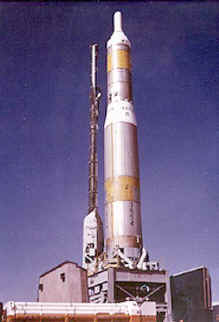|
|
 |
The two-stage Titan I, together with the Atlas, comprised our nation's first
generation of liquid-fueled, strategic, intercontinental ballistic missiles
(ICBMs). Operational Titan I's contained an all-inertial guidance system to
direct the nuclear warhead to the target. Liquid propellants for the Titan I's
Aerojet rocket engines were kerosene fuel and liquid oxygen. The HGM-25A,
formerly known as the SM-68 (or B-68), was the first USAF ICBM to be placed in
hardened underground silos for protection against enemy attack. However, they
had to be lifted from their silos to the surface by elevator prior to launching.
The USAF launched its first test Titan I on February 6, 1959 and in April
1962, the first Strategic Air Command squadron of nine Titan I's was declared
operational. Eventually squadrons of Titan I's were deployed at five different
bases in the western U.S. By 1965, however, Titan I's were being phased out in
favor of Titan II's which offer greater range and payload, and are launched from
within their silos. Modified Titan II's also were used to launch the Gemini
astronauts into space. The larger and more versatile Titan III, developed from
the Titan II, is one of the Air Force's major launch vehicles for its many
military space programs. |
|
